Best Crypto Faucets in 2025: Top 7 Free Testnet Token Sources

Summary: Crypto faucets give developers, blockchain testers, and airdrop farmers a quick, reliable way to get free testnet or small mainnet tokens for deploying smart contracts, debugging transactions, farming eligibility, and covering network fees, without spending real funds.
We assessed leading drip platforms across 70 crypto networks, evaluating token types, claim frequency, access requirements, and overall ease of use, before narrowing the field to our seven standout picks:
- QuickNode - Covers 55+ networks with 12h drips
- Chainlink - Supports 30+ chains with native and LINK tokens
- Alchemy - Refreshes every 24-72h across 10+ testnets
- L2Faucet - Issues tokens on 13+ Layer 2 networks
- Solana Devnet Faucet - Two clusters with 8h request limit
- Google Cloud Web3 Faucet - Testnet tokens on 10 chains
- Stakely Faucet - 40+ mainnets offering gas-fee top-ups
QuickNode gives developers reliable access to 55+ blockchain networks, pairing generous token limits with a clean, multi-chain interface that makes testing, deployment, and troubleshooting far more efficient.
Supported Faucets
Ethereum, Optimism, BNB Chain, Arbitrum, Polygon
Claim Frequency
One drip per network every 12 hours (if available)
Requirements
Hold 0.001 ETH or 0.05 SOL on mainnet in the claim wallet
Best Crypto Faucets in 2025
The best crypto faucets make getting free tokens a breeze, whether you’re building dApps, testing transactions, farming testnet airdrops, or just exploring new networks. After seeing how often users waste hours hunting for working faucets or waiting on slow drips, we set out to find the ones that truly get it right.
We reviewed over 25 faucets, spoke with active blockchain developers in several Discord and Telegram communities, and tested each service across multiple wallets. The final list includes only those faucets that passed our checks for network coverage, claim process, security measures, and consistent supply.
Below is our complete list of the top faucets in 2025:
1. QuickNode
QuickNode tops our list as the best free crypto faucet for its ability to deliver testnet tokens across 55+ supported blockchains in seconds. With wallet compatibility for MetaMask, Coinbase Wallet, Phantom, and Uniswap Wallet, it makes onboarding and testing almost frictionless for developers.
Its core strength lies in unifying multiple faucets under one interface, with one drip per network every 12 hours and a social-share bonus for extra tokens. This eliminates the tedious process of visiting separate faucets for Ethereum, Solana, Polygon, Blast, Unichain, and more.
While the requirement to hold a small amount of ETH or SOL on mainnet may deter brand-new users, the trade-off is access to a highly reliable and fast service. Overall, QuickNode is the most convenient faucet for multi-chain development, setting a high bar for the others on the list.
QuickNode Highlights:
- Available Chains: 55+ EVM-compatible networks, including Unichain, Ink, and Berachain.
- Rewards: 1 drip per network every 12 hours; bonus token for social share on X (Twitter).
- Requirement: Hold 0.001 ETH on Ethereum mainnet or 0.05 SOL on Solana mainnet.
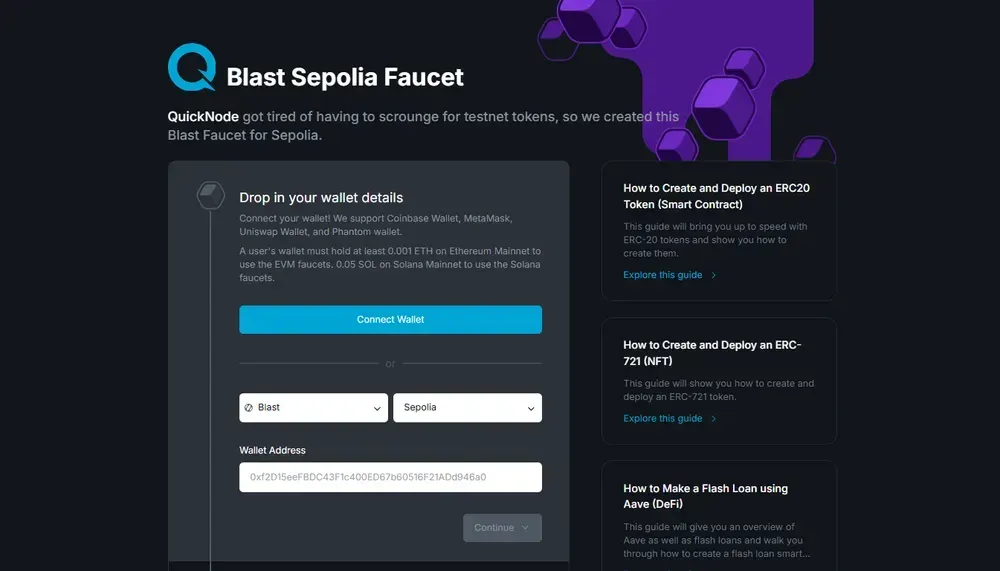
2. Chainlink
Chainlink’s faucet delivers a bundle of native testnet coins and LINK tokens, making it useful for standard DApp testing and oracle-specific development. Its catalog spans everything from Ethereum Sepolia testnet token to Avalanche Fuji, giving developers a playground of networks to experiment on.
Navigation is as easy as it gets thanks to a filterable faucet list, and you can queue multiple requests in one session. Wallet connection hooks in cleanly through MetaMask, Coinbase Wallet, or WalletConnect, keeping setup quick without being overly restrictive.
The fixed token amounts per drip may feel small for heavy simulation work, and certain assets are locked to specific networks. Still, the mix of asset types, network breadth, and streamlined request process makes Chainlink’s faucet a go-to resource for multi-environment testing.
Chainlink Highlights:
- Available Chains: 30+ networks, including Ethereum Sepolia, Avalanche Fuji, and Fantom Sonic.
- Rewards: 0.5 ETH, 0.5 AVAX, 0.5 POL, or 25 LINK per request, depending on network.
- Requirement: Connect a compatible crypto wallet.
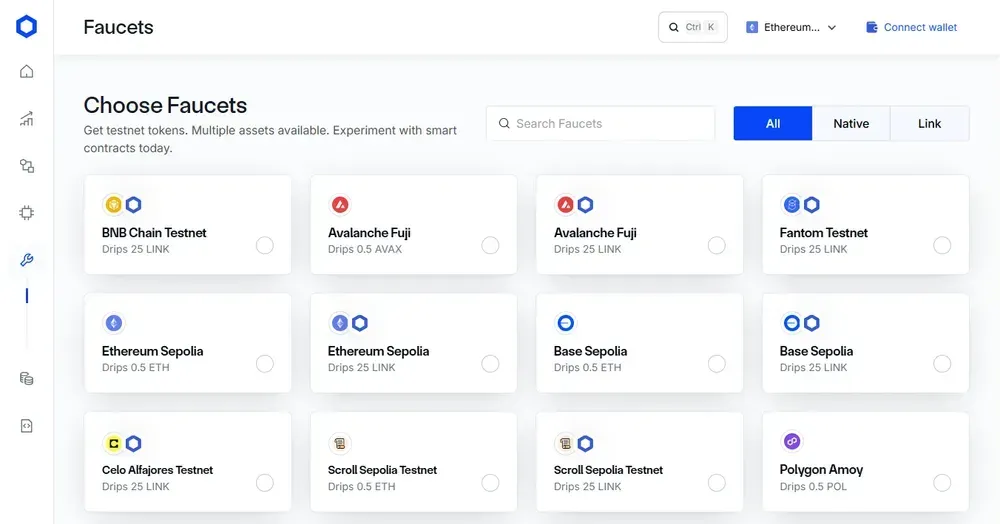
3. Alchemy
Alchemy’s faucet collection supports both widely used and emerging networks, including Ethereum Sepolia, Polygon Amoy, Arbitrum Sepolia, Starknet, and Monad. It’s built for developers seeking a dependable source of testnet tokens without having to complete social media verification steps.
The service works by signing into an Alchemy account, selecting the desired network, and submitting a wallet address to receive tokens instantly. Most networks refresh every 24 hours, while others distribute every 48 or 72 hours, ensuring steady availability without overwhelming supply.
While the account login may feel unnecessary for quick, one-time testing, it plays an important role in preventing abuse and maintaining token stability. With consistent refill schedules, varied chain support, and a clear claiming process, Alchemy’s faucets are a sound choice for ongoing development work.
Alchemy Highlights:
- Available Chains: 10+ networks, including Ethereum Sepolia, Polygon Amoy, and World.
- Rewards: 1 ETH, 1 MATIC, or 0.5 ETH on Starknet per 24 hours; some networks refresh at 48/72 hours.
- Requirement: Sign in with an Alchemy account.
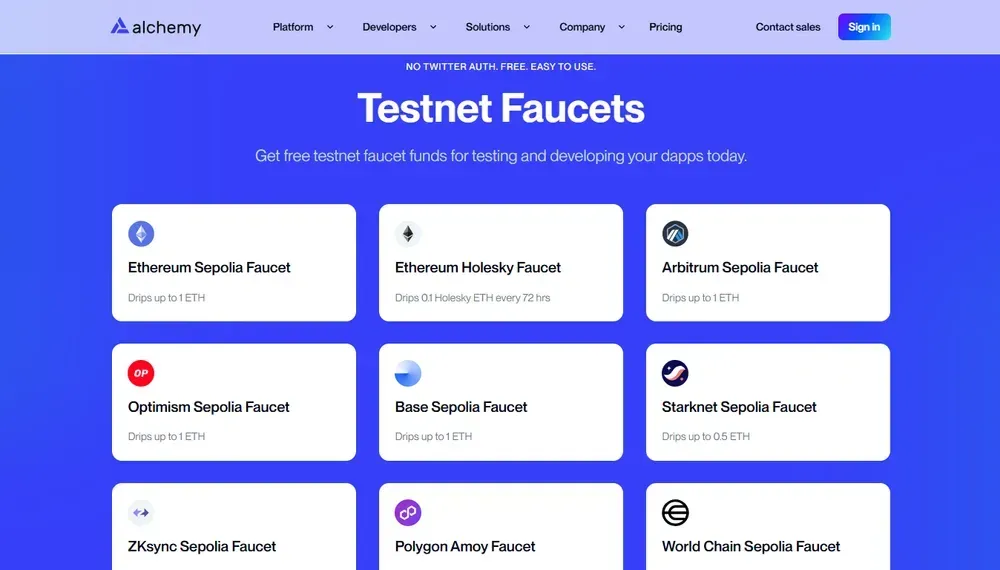
4. L2Faucet
L2Faucet distributes testnet tokens for more than a dozen Layer 2 and EVM-compatible chains through a single device attestation. It is primarily targeted to developers who need quick access to assets like ETH, USDC, and network-specific tokens without linking social accounts.
To claim, users verify their machine using WebAuthn or the Automata PoM app, a process that confirms authenticity before funds are sent. The faucet supports networks including Arbitrum Sepolia, Base testnet, Optimism, and Scroll, with 24-hour limits to keep distribution fair.
Device verification may feel unusual compared to standard faucets, but it strengthens security and ensures tokens go to real (non-bot) participants. For multi-chain builders, L2Faucet combines speed, privacy, and broad network coverage into a smooth ride for claiming tokens.
L2Faucet Highlights:
- Available Chains: 13+ networks, including Arbitrum Sepolia, Base Sepolia, Optimism, and Scroll.
- Rewards: Varies by network; includes ETH, USDC, and network-specific tokens.
- Requirement: Complete device attestation via WebAuthn or Automata PoM app.
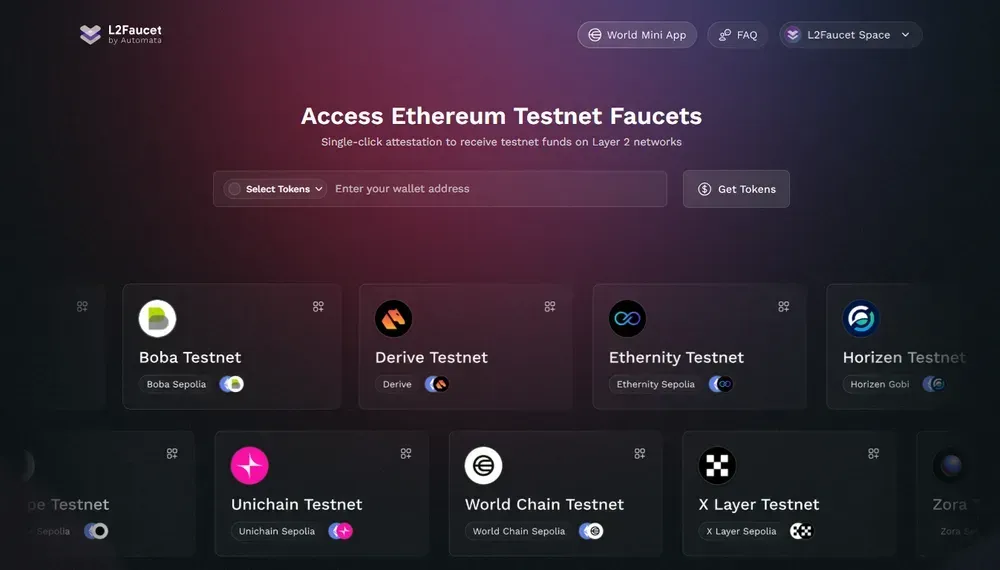
5. Solana Devnet Faucet
The official Solana Faucet provides developers with free SOL for building and testing programs in a no-risk environment, with tokens available on both Devnet and Testnet. Run by the Solana Foundation, it’s ideal for early experimentation on Devnet or accurate load testing on Testnet before mainnet deployment.
Requests can be made via the browser interface or Command Line Interface (CLI), with a limit of two airdrops every eight hours. Signing in through GitHub raises daily limits, while the Helius Devnet Faucet offers an alternative way, including its own dashboard and CLI access for teams on paid plans.
Although GitHub sign-in may feel unnecessary for light testing, it enables larger allocations for active builders and helps prevent exploitation. With predictable limits, two access options, and full coverage for Solana’s major test clusters, developers can choose between the official faucet or Helius’s version to fit their workflow.
Solana Devnet Faucet Highlights:
- Available Chains: Solana Devnet and Testnet.
- Rewards: Up to two airdrops every 8 hours; higher daily limits via GitHub sign-in.
- Requirement: Wallet address; optional GitHub sign-in for increased limits.

6. Google Cloud Web3 Faucet
The Google Cloud Web3 Faucet provides testnet tokens for multiple networks, including Ethereum Sepolia, Ethereum Holesky (now sunset), Celo Sepolia, ZetaChain, Injective, and more. Designed for developers building and testing smart contracts, it delivers assets directly to your wallet.
To use it, users sign in with a Google account, select the desired testnet (such as PYUSD Ethereum Sepolia, Story Aeneid, or Movement Bardock), enter a wallet address, and submit the request. The faucet sends a small amount of testnet tokens, with rate limits varying by network to ensure fair distribution.
While token arrival speed can depend on network congestion, the faucet’s integration with Google Cloud’s infrastructure provides reliability and transparency. With its broad token variety, simple request flow, and trusted brand backing, it’s a strong choice for Web3 developers working across diverse blockchain ecosystems.
Google Cloud Web3 Faucet Highlights:
- Available Chains: Multiple networks, including Ethereum Sepolia, Celo Sepolia, ZetaChain & Injective.
- Rewards: Varies by network, e.g., 0.05 Sepolia ETH, 1 Holesky ETH, or 1 CELO.
- Requirement: Google account and wallet address; rate limits vary by network.
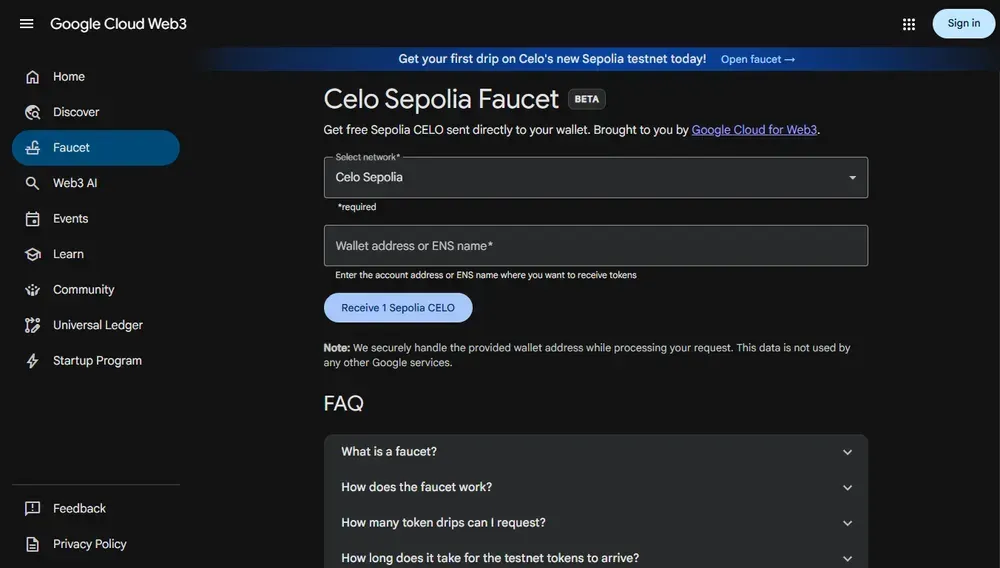
7. Stakely
As the final entry in our roundup, Stakely’s Multicoin Faucet offers free mainnet tokens to cover gas fees, making it ideal for keeping transactions moving when you’re low on funds. It supports over 40 networks, including CELO, Sui, Gnosis Chain, Cosmos, and Harmony, with no account registration required.
To claim, users simply enter their wallet address, solve a captcha, and tweet their request ID to verify the request. Tokens are sent directly to the wallet, providing a quick way to keep exploring networks or testing transactions without running into gas fee shortages.
Even though the tweet requirement may deter some users, it streamlines verification without storing personal data. With broad chain support, ease of use, and partnerships with major networks, Stakely is a reliable plan B for covering essential network fees.
Stakely Faucet Highlights
- Available Chains: 40+ networks, including CELO, Sui, Celestia, Cosmos, and Harmony.
- Rewards: Small amounts of mainnet tokens for gas fees.
- Requirement: Wallet address, captcha, and tweet with request ID.
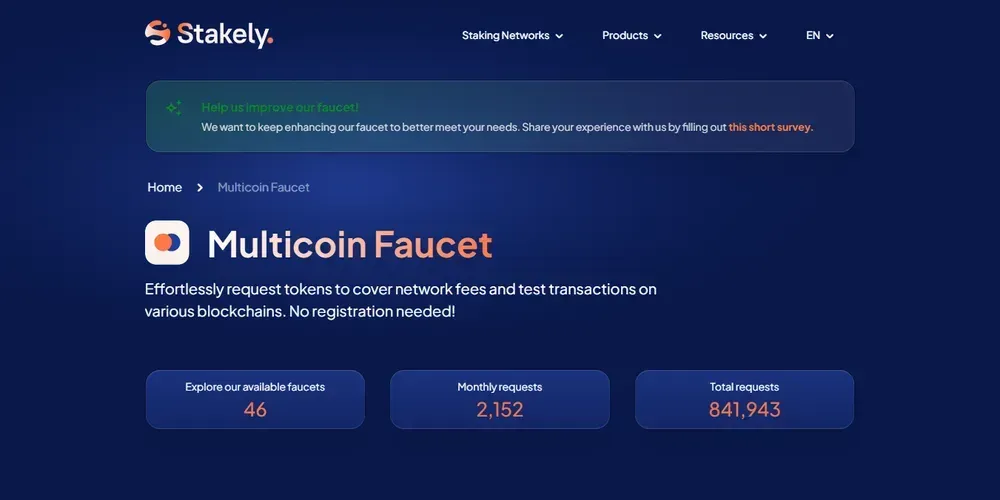
What is a Crypto Faucet?
A crypto faucet is an online tool or application that gives out small amounts of cryptocurrency for free, usually on a testnet or for promotional purposes. Its primary role is to let users experiment with blockchain transactions, smart contracts, and wallets without risking real funds.
For developers, faucets are essential for testing decentralized applications (dApps) in a live network environment that mirrors mainnet conditions. By providing testnet tokens with no real-world value, they enable debugging, feature trials, and performance checks before launching to the main network.
For everyday users, faucets offer a low-barrier way to learn how blockchain networks work, from sending tokens to using DeFi platforms. They have also played a role in airdrop farming, such as Berachain’s bArtio testnet where swaps, perpetual trading, and liquidity provision earned BERA allocation on mainnet.
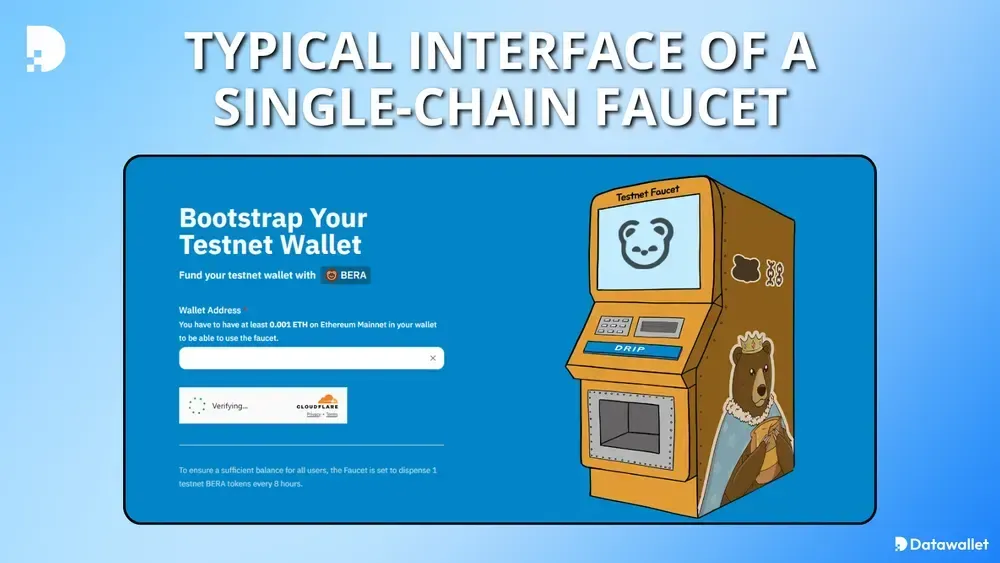
How Do Crypto Faucets Work?
Blockchain token faucets work by sending small amounts of cryptocurrency from a controlled crypto wallet to a user’s wallet after they complete a simple request process. They are designed to make blockchain testing and learning accessible without requiring real money.
Here’s how most crypto faucets operate:
- Request initiation: The user selects a network or token type and enters their wallet address into the faucet interface.
- Verification check: Some faucets require proof like captcha completion, social account linking, or device attestation to prevent spam and abuse of resources.
- Transaction creation: The faucet’s backend generates a blockchain transaction that sends the specified testnet or small mainnet amount to the user’s address.
- Network confirmation: The transaction is broadcast to the chosen blockchain’s network and confirmed by validators or miners.
- Rate limiting: A time-based restriction (e.g., once per 12 or 24 hours) ensures fair token distribution and preserves faucet reserves.
Fun fact: the very first Bitcoin faucet, launched by developer Gavin Andresen in 2010, gave away 5 real BTC per claim. At the time, they were worth only a few cents, but today that amount would be valued at over $600,000. It set the stage for the faucet model still used across blockchains.

How to Use a Crypto Faucet?
Using a crypto faucet is a clear and uncomplicated process that even beginners can follow. The goal is to receive small amounts of coins, often on a testnet, for smart contract testing or learning purposes.
Here’s the typical sequence for using a crypto faucet:
- Choose your faucet: Select a reputable faucet that supports the blockchain network or token you need.
- Prepare your wallet: Set up a compatible wallet (e.g., MetaMask, Phantom) and make sure it’s connected to the correct network.
- Enter your wallet address: Copy and paste your public wallet address into the faucet’s request form.
- Complete verification (if required): Complete a captcha, sign in with an account, or perform device attestation depending on the faucet’s rules.
- Submit the request: Confirm the action to trigger the faucet to send tokens.
- Wait for confirmation: Allow the transaction to process on the blockchain and check your wallet balance once it’s complete.
Are Crypto Faucets Worth it?
Crypto faucets are worth using for developers, testers, and learners who need free tokens to experiment with blockchain networks without risking real assets. They provide a low-cost, low-risk entry point for exploring smart contracts, transactions, and dApps like decentralized exchanges (DEXs).
Personally, we see them as a practical onramp for network-level experience, especially when paired with a clear learning goal. If you’ve got a girlfriend or boyfriend who’s curious about crypto, a faucet is a fun, low-risk way to get them started.
Are Crypto Faucets Safe?
Crypto faucets are generally safe when used from reputable sources, such as official project websites (like Monad's testnet tokens dripper) or well-known infrastructure providers. The main risks come from phishing sites or malicious faucets that try to collect private keys or install malware.
To stay safe, never share your wallet’s private key or seed phrase, and only provide your public address when requesting tokens. Checking community reviews, official documentation, and security practices can help ensure you’re using a trusted faucet.
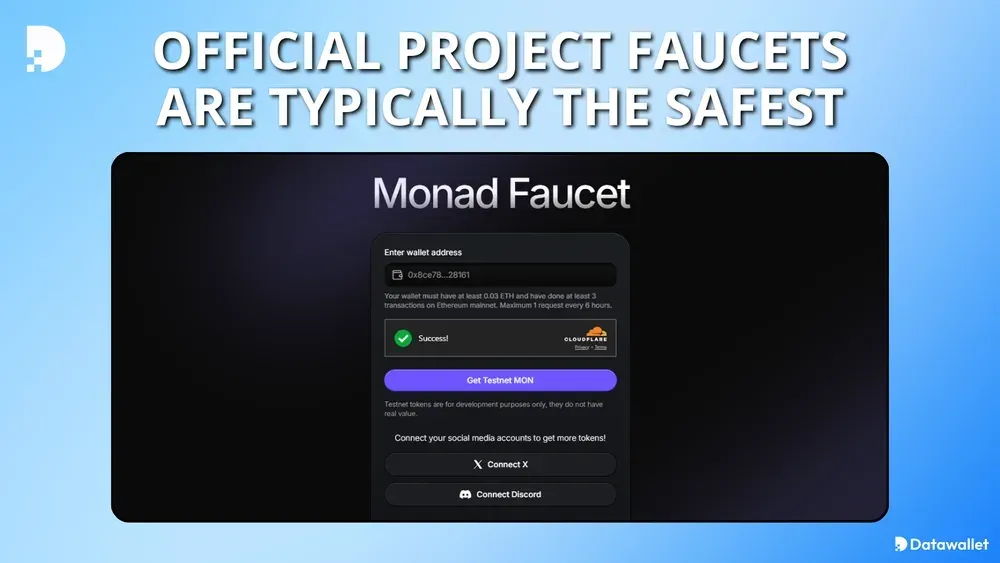
Final Thoughts
Sometimes, the difference between a stalled test deployment and a breakthrough build is simply having a reliable crypto faucet delivering the right tokens at the right moment.
Choose from our top-rated options in this article, led by QuickNode and Chainlink, keep them in your toolkit, and start claiming tokens today to power your next big blockchain project.
Frequently asked questions
Can I convert testnet tokens from a faucet into real cryptocurrency?
No, testnet tokens have no monetary value and cannot be converted to mainnet cryptocurrency. They are strictly for development, testing, and learning purposes.
Why do some crypto faucets require social media verification?
Social media verification helps prevent bots and automated scripts from draining the faucet’s reserves. It ensures tokens are distributed fairly among real users.
Do all blockchains have their own faucets?
Most major blockchains offer at least one official faucet for developers and testers. However, smaller or newer networks may rely on third-party faucets or community-run protocols.
How much cryptocurrency can I get from a faucet at once?
The amount varies depending on the faucet and network, with limits ranging from fractions of a token to several units. These caps help maintain supply and ensure fair access over time.
%25201%2520(1).webp)
Written by
Emily Shin
Research Analyst
Emily is passionate about Web 3 and has dedicated her writing to exploring decentralized finance, NFTs, GameFi, and the broader crypto culture. She excels at breaking down the complexities of these cutting-edge technologies, providing readers with clear and insightful explanations of their transformative power.
.svg)
.webp)

%2520(1).webp)

%2520(1).webp)




